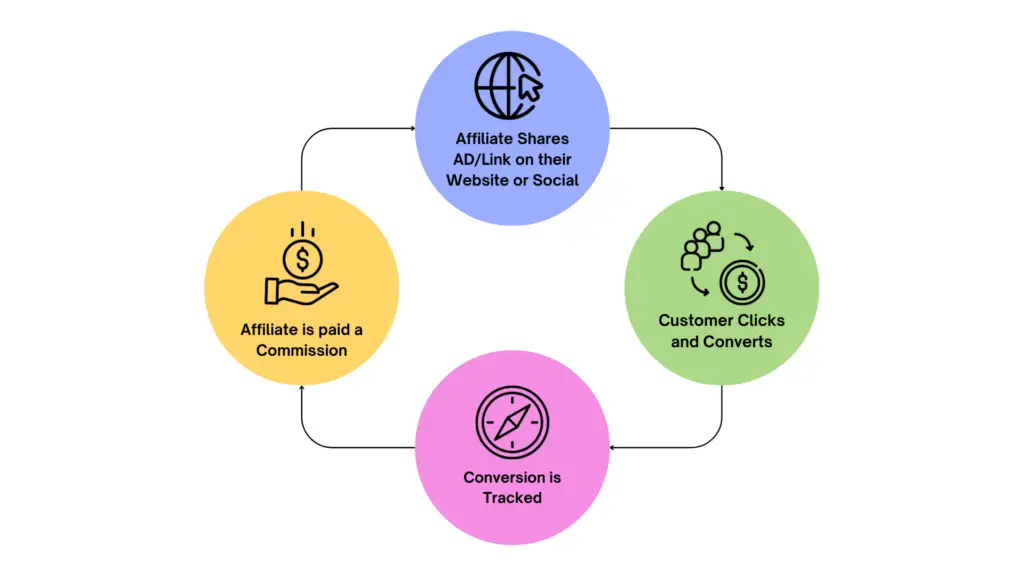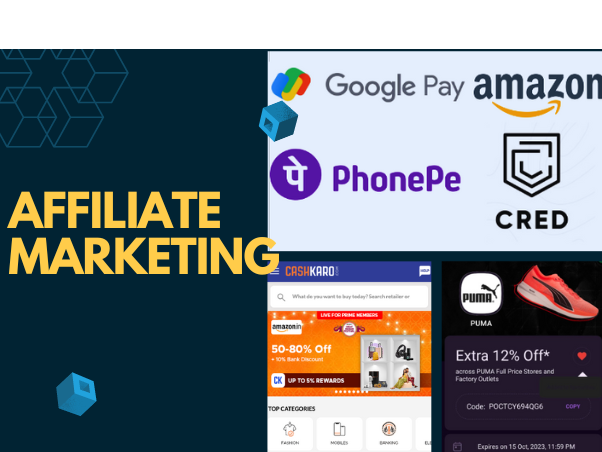In today’s continuously evolving digital landscape and constantly changing organisational needs, marketeers are pushing boundaries by applying innovative ways to engage their audience. Affiliate marketing is one such very effective performance-based strategy where businesses reward affiliates for driving traffic or sales to their products or services. The reason it is becoming increasingly popular is because it is cost effective, can reach a wider audience and lead to more conversions.
In this blog post, we will explore what affiliate marketing is, how it works, its advantages, different types of affiliate marketing, pricing models, metrics that dictate the success of an affiliate marketing campaign, how to successfully execute an affiliate program, and the issue of affiliate fraud. Let’s dive in!
Table of Contents:
- What is Affiliate marketing?
- How Affiliate Marketing Works
- Advantages of Affiliate marketing
- Types of Affiliate marketing
- Why are UPI apps being used as a source of Affiliate marketing?
- Pricing Model
- Metrics dictating success of an Affiliate Marketing Campaign : ABC
- How to successfully execute an Affiliate program?
- Affiliate fraud Red flags
- Conclusion
To know more about how your brand can leverage affiliate marketing strategies
1. What is Affiliate marketing?
Affiliate marketing is a process where a brand’s affiliate promotes products or services in order to earn in exchange for a commission. It’s a low cost technique where each sale is tracked via affiliate links from one website to another. Successful affiliates leverage various channels, such as websites, blogs, or social media, to promote products effectively. The key lies in understanding your audience, selecting relevant products, and employing persuasive content to encourage conversions. Tracking and analytics play a crucial role in assessing campaign effectiveness and optimising strategies for maximum returns.
Affiliate marketing has become a high-value, low-risk way to drive sales and brand awareness for companies—and to generate revenue for their affiliates. It’s a $17 billion industry globally with plenty of opportunity for those looking to make money online.
According to Business Insider, 15% of e-commerce revenue can be attributed to affiliate marketing.
2. How Affiliate Marketing Works

Affiliate Shares AD/Link on their Website or Social: Affiliates promote products or services by sharing unique affiliate links or ads on their websites, blogs, or social media platforms.
Customer Clicks and Converts: When a potential customer clicks on the affiliate link and makes a purchase or completes a desired action (conversion), the affiliate earns a commission.
Conversion is Tracked: Tracking mechanisms, such as cookies or unique tracking codes, monitor the customer’s journey from the affiliate link to the conversion, ensuring proper attribution to the affiliate.
Affiliates are paid a Commission: Once the conversion is confirmed and validated, the affiliate receives a predetermined commission, which is often a percentage of the sale or a fixed amount agreed upon in the affiliate program terms.
3. Advantages of Affiliate marketing
- Low Cost – Low Risk: Affiliate marketing requires minimal upfront investment as marketers only pay commissions for actual sales or leads, minimising financial risk.
- Performance-Based Marketing: The model is results-driven, with marketers paying affiliates based on their performance, typically through a commission structure tied to sales or conversions.
- Targeted Reach and Scalability: Marketers can partner with affiliates whose audience aligns with their target market, ensuring a focused reach. Additionally, the affiliate network can be scaled easily to reach a broader audience.
- High Potential ROI: Since marketers only pay for actual conversions, the return on investment (ROI) potential is high, making it a cost-effective marketing strategy with the potential for significant profit.
4. Types of Affiliate marketing
The different types of affiliate marketing could be the use of coupon platforms , affiliate networks, review websites, user groups or lock screen.

5. Why are UPI apps being used as a source of Affiliate marketing?

Today in India there are more than 500 Million users of UPI app and more people are getting added daily. UPI users have a higher MAU and transaction frequency. With its widest reach and behavior information of customers, it is a good platform. The top UPI players in the country are PhonePe, Google Pe and Paytm.
High Volume of frequent users makes it an ideal platform for Affiliate marketing by utilising its
- Frequent transactions: UPI facilitates daily transactions for various needs, from bill payments to online shopping, increasing the chances of users encountering affiliate offers.
- In-app visibility: UPI apps offer dedicated sections for displaying deals and promotions, allowing targeted advertising based on user behaviour and preference
- Massive user base: UPI apps like Paytm, PhonePe, and Google Pay boast millions of active users, providing a vast potential audience for affiliate campaigns.
UPI payments are one of the best performing platforms right now when compared to other Affiliate marketing platforms


6. Pricing Model
- Pay per sale (PPS) – Affiliate earns a commission every time a customer purchases a product or service through their referral link.
- Pay per lead (PPL)– Affiliate receives a commission for each lead generated for the company.
- Pay per click (PPC) – Affiliate is paid every time a customer clicks on their referral link.
- Pay per impression (PPI) – Affiliate is paid for each impression generated by their referral link.
7. Metrics dictating success of an Affiliate Marketing Campaign : ABC
The ABC metrics for measuring the success of an Affiliate Marketing Campaign- Acquisition, Behavior, and Conversion—are fundamental to understanding the performance and effectiveness of your campaign. Let’s delve into each metric in more detail:



Regularly reviewing the Affiliate’s Performance and tracking key metrics such as traffic conversion rate and ROI are the keys to managing affiliate marketing.
Having a robust Traffic Attribution Model is a must for the effective execution of the Campaigns
Marketers are at the forefront of this dynamic ecosystem. To truly harness the potential of affiliate marketing, marketers need to adopt a data-centric mindset.
8. How to successfully execute an Affiliate program?
Choose the right affiliates: Select affiliates who align with your target audience and are genuinely interested in your products or services.Use analytics to identify high-performing partners based on historical data, conversion rates, and customer engagement. Strategic affiliate partnerships can boost conversion rates by 30%.
Provide attractive incentives: Offer competitive commission rates and provide affiliates with exclusive deals or promotions to motivate them.
Offer quality marketing materials: Provide affiliates with high-quality banners, images, and content to effectively promote your products or services.Leverage analytics to understand audience preferences and behaviours. Tailor content strategies to maximise conversions.
Track and analyze performance: Continuous monitoring is vital.Use tracking tools to monitor the performance of your affiliates and optimize your program based on data-driven insights.
Attribution Modelling: Accurately attribute conversions by employing advanced analytics attribution models. Companies using multi-touch attribution models experience a 30% increase in ROI. Fairly allocate commissions and optimise budgets for maximum return.
Predictive Analytics: Anticipate trends and future opportunities with predictive analytics. Forecast trends, identify emerging affiliates, and adapt strategies for sustained success in Use analytics to identify high-performing partners based on historical data, conversion rates, and customer engagement. Strategic affiliate partnerships can boost conversion rates by 30%.
9. Affiliate fraud Red flags
- Fake referrals: Affiliates generating fake leads or sales to earn higher commissions.
- Cookie stuffing: Affiliates using unethical tactics to force cookies onto users’ browsers, falsely claiming credit for referrals.
- Trademark infringement: Affiliates using the business’s trademark without permission.
But most importantly, UTM or Urchin Tracking Module plays an important role in fraud prevention by:
- Tracking traffic source and behavior: Identifying suspicious campaigns, filtering out bad traffic, and analyzing conversion paths.
- Identifying fraudulent clicks: Checking quick conversions, suspicious IPs, and overall traffic quality.
Overall, be wary of any affiliate activity that seems too good to be true, or that deviates from your normal traffic patterns.
10. Conclusion
Affiliate marketing is a powerful tool for driving efficient growth and expanding a business’s customer base. By leveraging the reach and influence of affiliates, businesses can tap into new markets, increase brand exposure, and achieve a higher return on investment. However, it is crucial to carefully select affiliates, track performance metrics, and be vigilant against affiliate fraud. With the right strategies and execution, businesses can unlock the full potential of affiliate marketing and drive sustainable growth.
You can reach out to us at DAIOM to assist you in crafting the affiliate marketing strategies for driving growth.
Also, Check out our latest blog delving deeper into WhatsApp Marketing For Business


